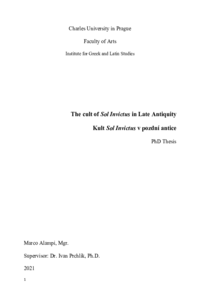The cult of Sol Invictus in Late Antiquity
Kult Sol Invictus v pozdní antice
dissertation thesis (NOT DEFENDED)

View/
Permanent link
http://hdl.handle.net/20.500.11956/176157Identifiers
Study Information System: 168796
Collections
- Kvalifikační práce [24008]
Author
Advisor
Referee
do Amparo Alfonso Teixera, Cláudia
Chiai, Gian Franco
Faculty / Institute
Faculty of Arts
Discipline
Ancient History
Department
Institute for Greek and Latin Studies
Date of defense
13. 12. 2021
Publisher
Univerzita Karlova, Filozofická fakultaLanguage
English
Grade
Fail
Keywords (Czech)
Sol Invictus|Pozdní antika|kult|sluneční ikonografie|sluneční božstvo|Severovská dynastie|Elagabalus|henoteismus|náboženský synkretismus|pozdně římská říše|římské dějiny|Historia Augusta|damnatio memoriae|imperiální propagandaKeywords (English)
Sol Invictus|Late Antiquity|cult|solar iconography|sun god|Severan dynasty|Elagabalus|henotheism|religious syncretism|late roman empire|roman history|Historia Augusta|damnatio memoriae|imperial propagandaTato disertační práce se věnuje vývoji jednoho z nejzajímavějších kultů, které se objevily a rozvinuly během pozdní antiky: kultu Nepřemožitelného slunce (Sol Invictus). Ačkoli se stopy po uctívání slunce v římské říši objevují již od počátku římských dějin, kult boha Sola získává originální a zajímavé rysy na konci 3. století. Je nutné odlišit sluneční božstvo uctívané v soukromých a iniciačních kruzích (Mithrova mystéria) od veřejných svátků a obřadů zavedených pro boha Slunce. V této práci je analyzována výhradně veřejná bohoslužba, se zvláštním důrazem na časový rámec sahající od vlády posledního z Antoninů, Commoda (180-192), až po Severa Alexandra a jeho nástup na trůn (222-235). Specifická volba padla na toto konkrétní historické momentum, které, pomineme-li skutečnosti, jež by již mohly být definovány jako pozdně antické rysy, je také dobou, ve které si sluneční kult získává přízeň mezi různými společenskými vrstvami a objevuje se, zdá se, hojná ikonografie spojená se Sol Invictus (z níž je možná nejoriginálnější a nejvýraznější případ Elagabala a jeho boha, Sol Invictus Elagabal). Tato práce nejprve analyzuje a srovnává literární a neliterární prameny ke kultu Sol Invictus tak, aby bylo možné shromáždit informace o kultické praxi slunečního kultu a zároveň stanovit spolehlivost pramenů, které máme...
This Ph.D. dissertation focuses on the development of one of the most interesting cults spread and grown during Late Antiquity: the cult of Sol Invictus. Although traces of a sun worship in the Roman Empire are dated since the beginning of the Roman history, the cult of Sol acquires, at the end of the III century, original and interesting features. It is necessary to distinguish the sun deity as worshipped in private and initiatory circles (the Mithraic mysteries) from the public festivals and rites made for the sun god. In this work exclusively the public worship of the cult is analyzed, with a specific attention to the time frame which spans from the reign of the last of the Antonines, Commodus (180-192), until the ascension to the throne of Severus Alexander (222-235). This specific choice is due to the fact that this particular historical momentum, apart from having features that could be already defined as Late Antique traits, is also the time in which the sun cult gains favor among different social classes and iconography connected with Sol Invictus appears to be, during these times, abundant (of all, the case of Elagabalus and his god Sol Invictus Elagabal is perhaps the most original and striking). This work first puts in analysis and comparison literary and non-literary evidence concerning Sol...
